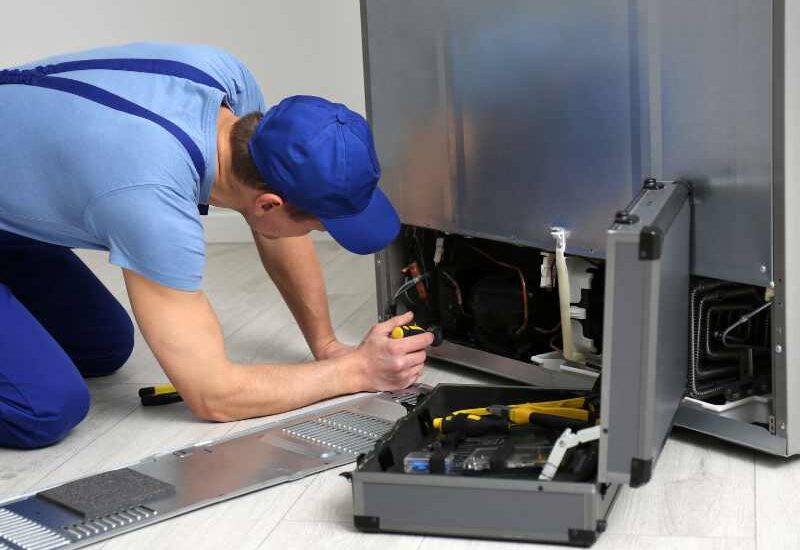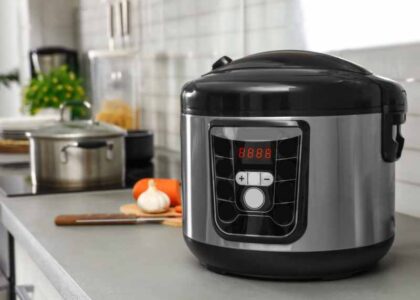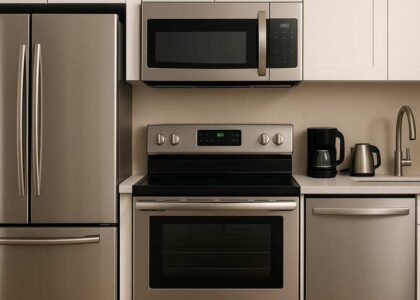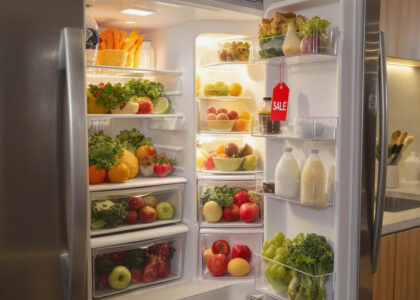A fridge leaking water is one of the most common household issues that can happen in any home, whether you live in a downtown apartment or a suburban house in Orlando, FL. It often starts as a small puddle you might overlook — until it spreads and causes bigger problems. If left unchecked, you may need professional help from a trusted Refrigerator Repair Orlando service to prevent water damage, spoiled food, or electrical hazards.
2. Common Signs Your Fridge Is Leaking
Before jumping into repairs, it’s important to recognize the early warning signs of a fridge leaking water. Catching the problem early can save you from water damage, food spoilage, and costly service calls. Here are the most common indicators to watch for:
- Puddle of water under or inside the fridge:
The most obvious sign — you may notice a small puddle forming near the bottom front or back of your refrigerator. Sometimes, the water collects under the drawers or along the inside shelves. - Water dripping from the dispenser or freezer:
If you see drips from the water dispenser or melting ice forming around the freezer compartment, it could mean a faulty water line, clogged drain, or defrost issue. - Damp or moldy smell near the bottom:
Persistent moisture under the fridge creates the perfect environment for mold and bacteria. A musty odor is often a sign that water has been pooling unseen for days or weeks. - Condensation around the door gasket:
When warm air leaks through a worn or dirty door seal, it meets the cold interior air and forms condensation. Over time, that excess moisture can drip down and create puddles.
If you notice any of these symptoms, it’s time to inspect your fridge more closely and identify where the leak is coming from.
3. Main Causes of Fridge Leaking Water
When your refrigerator starts leaking, it’s usually caused by a simple mechanical or drainage issue. Understanding the root cause helps you fix the problem quickly and prevent future leaks. Below are the two most common culprits behind a fridge leaking water.
3.1 Blocked Defrost Drain
Every modern refrigerator has a defrost system that automatically melts ice buildup from the freezer coils. The melted water is designed to flow down through a small drain hole and into a drain pan located underneath the fridge, where it naturally evaporates.
However, over time, this drain can become clogged with food particles, dirt, or ice. When that happens, the melted water has nowhere to go and starts to back up inside the fridge or freezer. Eventually, it drips out onto the floor, leaving you with a messy puddle.
Signs of a blocked defrost drain include:
- Standing water under the crisper drawers
- Ice buildup at the bottom of the freezer
- Water dripping from the back wall of the fridge
3.2 Faulty or Disconnected Water Line
If your refrigerator has an ice maker or water dispenser, it’s connected to a small water supply line at the back of the unit. This line brings in fresh water from your home’s plumbing system. Over time, the tubing can crack, loosen, or disconnect, especially in humid climates like Orlando, where temperature changes can affect plastic materials.
How to identify a water line leak:
- Check behind the fridge for any signs of moisture, dripping, or small puddles near the water connection.
- Look for white mineral buildup or corrosion around fittings, which indicates slow leaks.
- If you see water collecting under the back corners of the fridge, it’s often a sign the water line is loose or cracked.
3.3 Cracked or Clogged Drain Pan
At the bottom of every refrigerator, there’s a drain pan that collects water from the defrost system. Its main function is to hold the melted frost water that drains down from the freezer, allowing it to evaporate naturally through the warm air produced by the condenser coils.
Over time, however, this pan can become clogged with dust, debris, or mold, which prevents proper evaporation. In other cases, the drain pan itself might develop a crack or small hole, causing water to leak directly onto the floor.
What happens when this occurs:
- You may notice a constant puddle beneath the fridge even after cleaning.
- A faint, musty odor can develop from standing water or mold buildup.
- The bottom edges of the fridge or nearby floorboards may start to swell or discolor from water damage.
3.4 Freezer Defrosting Issues
Another reason behind a fridge leaking water is improper freezer defrosting. When the defrost cycle isn’t working correctly, ice can build up on the freezer coils and around the drain. Eventually, this ice melts unevenly and leaks into the refrigerator compartment or onto the floor.
The problem is often caused by a faulty defrost heater, thermostat, or timer. When any of these components fail, the freezer can’t regulate its melting process, leading to excess water accumulation.
Common symptoms include:
- Water pooling in the bottom of the freezer
- Ice forming on the back wall
- Leaks showing up a day or two after a defrost cycle
3.5 Damaged Door Seal (Gasket)
The door gasket — the rubber seal that runs around your fridge and freezer doors — is essential for keeping cold air in and warm air out. When the gasket is cracked, dirty, or loose, warm humid air seeps inside. That warm air mixes with the cold environment, creating excess condensation that eventually drips and collects as water..
Maintaining a tight seal not only prevents leaks but also helps your refrigerator stay energy-efficient.
3.6 Improper Leveling
Believe it or not, a fridge that isn’t level can cause leaking problems. Refrigerators are designed to sit with a slight backward tilt so that condensation and defrost water drain naturally toward the back — into the drain hole and pan.
When the appliance leans too far forward or to one side, water can’t drain properly. Instead, it may pool inside the compartments or drip out the front.
4. Step-by-Step Troubleshooting Guide
If your fridge is leaking water, you can often find and fix the issue yourself with a little patience and a few basic tools. Follow these step-by-step instructions to safely troubleshoot the problem:
1. Unplug and Inspect for Visible Leaks
Start by unplugging your refrigerator to ensure safety while working. Move it slightly away from the wall and check the surrounding area for visible signs of moisture. Look under the fridge, around the back panel, and along the sides for any puddles or drips. This initial inspection will help you locate the general source of the leak.
2. Check the Drain Hole and Clean It
Locate the defrost drain hole, usually found at the back of the freezer or bottom of the refrigerator compartment. If it’s clogged with ice, food debris, or grime, the water can’t flow into the drain pan as it should.
Use hot (not boiling) water and a pipe cleaner or turkey baster to flush the hole until the blockage clears. Once the drain is open, you should see water flowing freely into the pan below.
3. Inspect and Reconnect Water Supply Lines
If your fridge includes an ice maker or water dispenser, check the water supply line connected to the back. Look for cracks, loose fittings, or slow drips. Tighten any loose connections and replace damaged tubing if necessary. Always turn off the water supply valve before making adjustments.
4. Remove and Clean the Drain Pan
Pull off the lower front or back access panel and slide out the drain pan carefully. Empty any standing water, then wash it with warm, soapy water to remove mold, dust, or mineral deposits.
If you notice cracks or leaks in the pan, replace it — they’re inexpensive and easy to install.
5. Level the Fridge with a Spirit Level
Place a spirit level on top of your refrigerator to check its alignment. The front of the fridge should be slightly higher than the back, allowing water to flow into the drain pan instead of pooling inside.
Adjust the leveling legs at the bottom until the unit sits evenly and firmly on the floor.
6. Defrost if Ice Buildup Is Visible
If you see thick ice layers inside the freezer or around the drain, the best solution is a manual defrost. Unplug the refrigerator and leave the doors open for several hours to let the ice melt completely. Wipe up excess water before plugging it back in.
Persistent ice buildup may indicate a problem with the defrost thermostat or heater, which might require professional repair.
7. Replace Any Damaged Parts
After checking everything, inspect for damaged seals, cracked hoses, or broken components. Replacing faulty parts like the door gasket, drain pan, or water tubing will ensure your fridge stays leak-free. Always use manufacturer-approved parts for your refrigerator model.
5. When to Call a Professional
While many cases of a fridge leaking water can be fixed with a few simple DIY steps, some situations require the expertise of a trained appliance technician. Knowing when to stop troubleshooting on your own can prevent further damage — and even save your refrigerator from a costly breakdown. If the leak persists or involves electrical components, it’s best to contact local Appliance Repair Services Orlando to ensure a safe and effective repair.
Here are the main situations when it’s best to call a professional:
• Persistent Leaks Despite Cleaning
If you’ve already cleaned the drain hole, checked the water line, and leveled the fridge but water still keeps pooling under or inside it, there may be a deeper mechanical issue. Continuous leaks could point to a hidden problem in the defrost system, compressor area, or sealed internal tubing that only a technician can properly diagnose.
• Electrical or Internal Component Issues
Never try to repair or open electrical parts of your refrigerator yourself. If you notice sparking, strange noises, a burning smell, or fluctuating temperatures, unplug the appliance immediately and call for professional help.
Licensed technicians have the tools and training to safely inspect defrost heaters, thermostats, and control boards — components that can be dangerous to handle without experience.
• Warranty Considerations — Why DIY Repairs Can Void It
If your refrigerator is still under manufacturer or extended warranty, performing your own repairs may void the coverage. Many brands require that maintenance and part replacements be done by an authorized service provider.
Before attempting any major fix, check your warranty terms or contact customer support. If the appliance is still covered, scheduling a service call will ensure the issue is handled correctly and at minimal or no cost to you.
A fridge leaking water can seem alarming at first, but in most cases, it’s a minor issue caused by something simple — like a clogged defrost drain, loose water line, or uneven leveling. By identifying the source early and following basic troubleshooting steps, you can usually stop the leak and prevent further damage without needing major repairs.
Remember, most refrigerator leaks are easy to fix at home with a bit of care and observation. Regular maintenance — such as cleaning the drain hole, inspecting the door gasket, and keeping the fridge level — helps prevent these issues from returning and ensures your appliance continues running efficiently for years.
If you ever face persistent or complex leaks, don’t hesitate to call a professional technician. With proper attention and upkeep, your refrigerator will stay dry, reliable, and energy-efficient — keeping your food fresh and your kitchen safe.
8. FAQ Section
Here are some frequently asked questions about a fridge leaking water and their answers:
Q: Why is my fridge leaking inside but not outside?
A: If water is pooling inside the refrigerator but not under it, the defrost drain may be clogged or frozen, preventing water from reaching the drain pan. Cleaning the drain hole usually solves this problem.
Q: Can a leaking fridge increase electricity bills?
A: Yes. When a refrigerator leaks or has blocked drainage, the compressor may work harder to maintain the correct temperature. This extra effort uses more electricity, leading to higher energy bills over time.
Q: How often should I clean the drain hole?
A: It’s a good practice to clean the drain hole every 3–6 months, or more frequently if you notice water pooling inside. Regular cleaning prevents clogs, ice buildup, and unpleasant odors.
Q: Is it safe to keep using a leaking refrigerator?
A: Minor leaks can be managed temporarily by mopping up water, but persistent leaks can create mold, damage flooring, and pose electrical hazards. It’s best to address the leak promptly or call a professional if needed.






